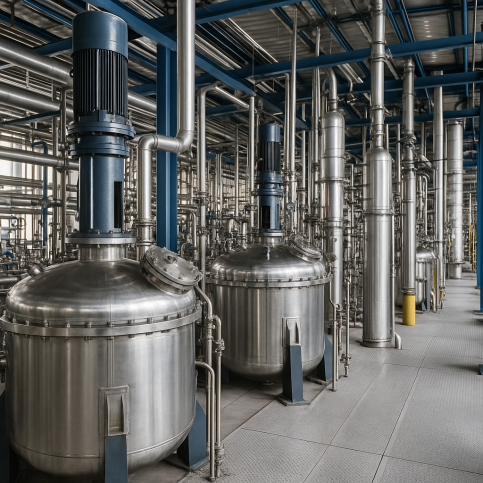Transesterification in Biodiesel: Chemistry, Catalysts & Process Optimization
At the heart of biodiesel production lies biodiesel transesterification, a chemical process that transforms natural oils and fats into fatty acid methyl esters (FAME). This reaction is the cornerstone of modern biodiesel manufacturing, defining the fuel’s quality, efficiency, and environmental impact. As the industry advances toward 2025 and beyond, understanding the chemistry and optimization of transesterification is essential for producers, engineers, and policymakers.
What is Transesterification in Biodiesel?
Transesterification is a chemical reaction between triglycerides—found in oils and fats—and an alcohol, typically methanol, in the presence of a catalyst. The result is fatty acid methyl esters (FAME), which form biodiesel, and glycerol as a by-product. This process lowers the viscosity of oils and fats, making them suitable for diesel engines without modification.
The overall reaction can be summarized as:
Triglyceride + Methanol → Fatty Acid Methyl Esters (Biodiesel) + Glycerol
While simple in theory, the reaction’s efficiency depends on multiple factors: catalyst type, feedstock quality, reaction temperature, molar ratios, and purification techniques. Optimizing these parameters is critical to achieving high yields and meeting international biodiesel standards such as EN 14214 and ASTM D6751.
Chemistry of the Transesterification Reaction
The biodiesel transesterification process involves breaking down triglycerides into three separate FAME molecules and one molecule of glycerol. Catalysts play a crucial role by lowering activation energy and speeding up the reaction. Depending on the catalyst used, the process can be categorized as:
- Base-catalyzed transesterification: Uses sodium hydroxide (NaOH) or potassium hydroxide (KOH). Most common due to low cost and high efficiency.
- Acid-catalyzed transesterification: Uses sulfuric acid (H₂SO₄). Effective for feedstocks with high free fatty acids (FFA), but slower than base-catalyzed methods.
- Enzymatic transesterification: Uses lipase enzymes. Environmentally friendly, but more expensive and slower.
Base-Catalyzed Transesterification
The base-catalyzed process accounts for more than 80% of commercial biodiesel production. Advantages include high reaction rates and relatively mild conditions (60°C, atmospheric pressure). Challenges involve sensitivity to water and free fatty acids, which lead to soap formation and yield losses. Pretreatment of feedstocks is often required to reduce FFA levels before the main reaction.
Acid-Catalyzed Transesterification
Acid catalysts can directly esterify free fatty acids, making them ideal for low-cost feedstocks like used cooking oil or animal fats. However, reaction times are longer, and higher methanol-to-oil ratios are required. In practice, acid catalysis is often used as a pretreatment step before base-catalyzed transesterification.
Enzymatic Transesterification
Enzymatic processes using lipase catalysts are gaining interest due to their eco-friendly nature and ability to handle high FFA feedstocks without soap formation. Immobilized enzymes also allow catalyst reuse. The main drawbacks remain high enzyme costs and slower reaction kinetics, but advances in biotechnology are steadily improving viability.
Heterogeneous Catalysts
A major innovation in biodiesel transesterification is the development of heterogeneous catalysts. Unlike homogeneous catalysts (liquid phase), heterogeneous catalysts are solids, making them easier to separate and reuse. Examples include calcium oxide, magnesium oxide, and zeolites. These catalysts simplify purification and reduce wastewater generation, aligning with sustainability goals.
Process Parameters and Optimization
Optimizing the transesterification process requires balancing multiple variables:
- Molar ratio of alcohol to oil: Typically 6:1 for base-catalyzed, but may vary with feedstock and catalyst type.
- Reaction temperature: Higher temperatures accelerate reaction rates but may cause methanol loss.
- Catalyst concentration: Excess catalyst can cause soap formation, reducing yield.
- Reaction time: Adequate mixing and sufficient duration are needed for complete conversion.
- Pretreatment: Essential for waste oils or animal fats with high water or FFA content.
Pretreatment of Feedstocks
Feedstock quality has a profound effect on transesterification efficiency. Used cooking oil, animal fats, and other waste sources often contain water and free fatty acids that interfere with base-catalyzed processes. Pretreatment options include:
- Acid esterification to reduce FFAs.
- Dehydration to remove water content.
- Filtration to eliminate impurities.
Effective pretreatment ensures higher yields, better fuel quality, and fewer downstream purification challenges.
Innovations in Biodiesel Transesterification
The industry continues to innovate, improving both efficiency and sustainability. Emerging trends include:
- Supercritical methanol processes, which eliminate the need for catalysts but require higher temperatures and pressures.
- Ultrasound and microwave-assisted transesterification, which enhance reaction kinetics and reduce energy consumption.
- Nanocatalysts, offering higher surface area and reactivity compared to traditional catalysts.
Purification and By-Product Utilization
After transesterification, biodiesel must be purified to remove glycerol, catalysts, soaps, and unreacted alcohol. Common purification methods include water washing, dry washing with adsorbents, and membrane separation. The glycerol by-product, once considered waste, is now a valuable input for industries such as pharmaceuticals, cosmetics, and chemicals.
Economic and Sustainability Considerations
The economics of biodiesel production hinge on both feedstock and process efficiency. Advanced transesterification methods can reduce costs by improving yields and minimizing waste. Sustainability is also improved through cleaner catalysts, reduced water usage, and valorization of glycerol.
Conclusion
Biodiesel transesterification is a critical process that defines the technical and economic feasibility of biodiesel. From catalyst selection to process optimization, every step matters in ensuring high yields, low costs, and sustainable outcomes. As the industry faces rising demand and stricter regulations, innovations in transesterification chemistry will play a central role in securing the future of biodiesel.
Want to understand the complete biodiesel production chain, from feedstocks to refining and market outlook?

